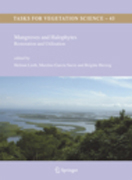
Mangroves and halophytes: restoration and utilisation
Lieth, H.
García Sucre, M.
Herzog, B.
Focusing on Venezuela and Mexico, this edited volume from the International Society of Halophyte Utilisation (ISHU) explores the environmental issues facing South and Central America's coastal ecosystems, and discusses the uses of mangrove species and other halophytes in addressing issues of both coastal pollution and upland soil salinisation. The book draws on expertise from Europe andSouth America to present a series of case studies that detail Venezuela’s saline ecosystems and examine the economic potential of mangrove restoration and halophyte production. It includes cutting-edge research into the establishmentof new mangrove stands which could serve as prototypes for the sustainable use of halophytes, including Chenopodium quinoa and Tamarix aphylla. Moreover, the detailed examples from Venezuela and other Caribbean countries provide useful models for comparison with halophyte utilisation in other parts of the world. New cash crops with seawater irrigation Energy production CO2-sequestration INDICE: 1.1. Concepts for different uses of halophytes.- 1.2. The water crisis – the potential of cash crop halophytes to reduce the dilemma.- 1.3. Present efforts to develop sustainable saline production systems.- 1.4. Studies onhalophytes and salinity problems in Mediterranean agriculture.- 2.1. Investigations proposed in Venezuela for the development of systems for the sustainable utilisation of halophytes.- 2.2. Diagnostics about the state of mangroves inVenezuela.- 2.3. Contribution of seagrasses to the Venezuelan coastline vegetation.- 3.1. Comparative biochemical study of the rhizosphere of Rhizophora mangle and its associated species Cyperus sp.- 3.2. Creation of mangrove ‘productive oases’.- 3.3. Mangrove restoration in a tropical semiarid environment.- 3.4. Mangrove establishment on artificial islands.- 3.5. The effect of temperature on the accumulation of salts and chromium.- 3.6. Salt tolerance of Chenopodium quinoa Willd., grains of Andes.- 3.7. Biosaline biomass for energy.
- ISBN: 978-1-4020-6719-8
- Editorial: Springer
- Encuadernacion: Cartoné
- Páginas: 220
- Fecha Publicación: 01/02/2008
- Nº Volúmenes: 1
- Idioma: Inglés
